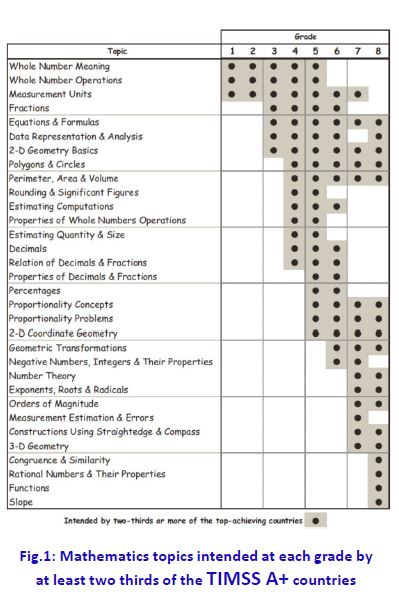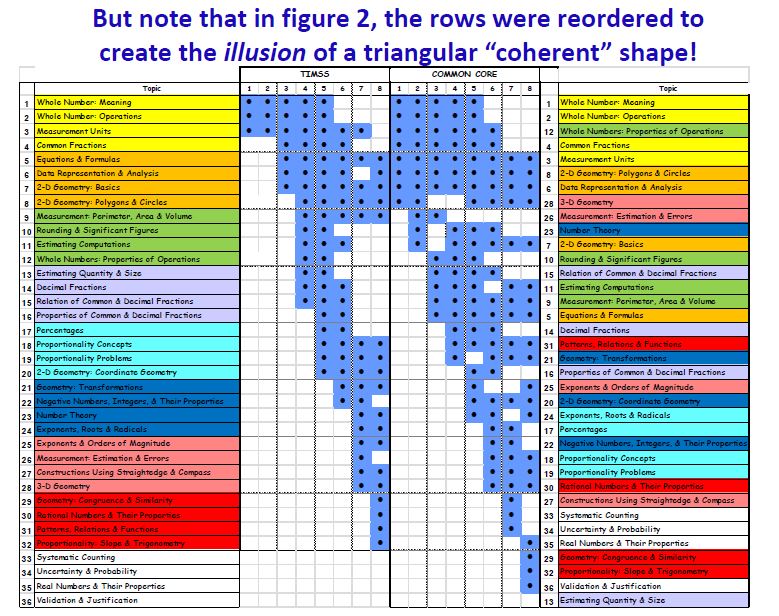ARE THE COMMON CORE STATE STANDARDS INTERNATIONALLY BENCHMARKED?
The Common Core State Standards Initiative (CCSSI), "Fact vs. Myths," website states: "International benchmarking played a significant role in both sets of standards. In fact, the college and career ready standards include an appendix listing the evidence that was consulted in drafting the standards and the international data consulted in the benchmarking process is included in this appendix. More evidence from international sources will be presented together with the final draft." Where are these tables? Why did the Common Core Validation Committee never see these International benchmarks before signing off on the standards then? Has the Arizona Department of Education (AZED) seen these International Benchmarks?

Ze'ev Wurman |
These International Benchmarks do not exist! When Ze'ev Wurman, from the Hoover Institution, presented to our state at the August 2, 2014 Common Core Forum, he showed that the only study that found the Common Core State Standards Initiative (CCSSI) on par with "international high achievers" was done by W.H. Schmidt and R.T. Houang in 2012 entitled "Curricular Coherence and the Common Core State Standards for Mathematics." Schmidt and Houang mapped the Common Core Mathematics standards based upon the same principles as the "Trends in International Math & Science Study" (TIMSS). In 1995, TIMSS was administered and the curricula of six "top-achieving" countries were studied, and they were considered "A+ countries"- Flemish, Belgium, Czech Republic, Hong Kong, Japan, Korea and Singapore scored the highest. Schmidt was the United States' TIMSS Coordinator at the time, but the TIMSS findings were verified by many others at that particular time and since then. Here is the graphic representation of the TIMSS findings which showed a "Coherent Sequence- Order of rows;" a "Focus- Limited number of grades per topic;" and "Depth- Limited number of topics per grade." This triangular shape in this graphic coveys what the results were in this TIMMS study:

|
The Common Core Standards were graphically represented by Schmidt and Haung and put up against this TIMSS study to show that they were supposedly "Internationally Benchmarked." However, the rows in this graphic, and when the standards for each grade level were introduced, were just "reordered" to create the illusion of a triangular "coherent" shape like what was portrayed in the TIMSS study! Schmidt and Houang still concluded that "There being no major difference between the two sets of standards, [TIMSS vs. CCSSI], this provides further evidence that the CCSSI are coherent and very consistent with the international benchmark." So Haung and Schmidt, due to this graphic comparision between TIMSS and CCSSI, claimed that CCSSI were "internationally benchmarked." This is all a lie! Let us read from the expert's testimony, the only English Language Arts standards writer and Mathematics Standards writer, who were on the Common Core Validation Committee in 2009, Dr. Sandra Stotsky and Dr. James Milgram, respectively.

|

Dr. Sandra Stotsky |

Dr. James Milgram |
![]() Dr. Sandra
Stotsky's, a Common Core Validation Committee Member, testimony before the Texas Legislature, on the Common Core English Language Arts
Standards:
Dr. Sandra
Stotsky's, a Common Core Validation Committee Member, testimony before the Texas Legislature, on the Common Core English Language Arts
Standards:
"Common Core's 'college readiness' standards for English language arts and reading do not aim for a level of achievement that signifies readiness for authentic college-level work. They point to no more than readiness for a high school diploma (and possibly not even that, depending on where the cut score is set). Despite claims to the contrary, they are not internationally benchmarked. States adopting Common Core's standards will damage the academic integrity of both their post-secondary institutions and their high schools precisely because Common Core's standards do not strengthen the high school curriculum and cannot reduce the current amount of post-secondary remedial coursework in a legitimate way."
"After the Common Core Initiative was launched in early 2009, the National Governors Association and the Council of Chief State School Officers never explained to the public what the qualifications were for membership on the standards-writing committees or how it would justify the specific standards they created. Most important, it never explained why Common Core's high school exit standards were equal to college admission requirements without qualification, even though this country's wide ranging post-secondary institutions use a variety of criteria for admission."
"Eventually responding to the many charges of a lack of transparency, the names of the 24 members of the 'Standards Development Work Group' were revealed in a July 1, 2009 news release. The vast majority, it appeared, work for testing companies. Not only did [Common Core State Standards Initiative] (CCSSI) give no rationale for the composition of this Work Group, it gave no rationale for the people it put on the two three-member teams in charge of writing the grade-level standards."
"Another seemingly important committee, a Validation Committee, was set up with great fanfare on September 24, 2009. The 25 members of this group were described as a group of national and international experts who would ensure that Common Core's standards were internationally benchmarked and supported by a body of research evidence. Even though several of us regularly asked to examine this supposed body of research evidence, it became clear why our requests were ignored. In December 2009, the Parent Teacher Association, indicated the real role of this committee--more like that of a rubber stamp. The PTA predicted that: "both sets of standards will be approved simultaneously in February 2010 by members of the Validation Committee." Why did it think so? Why did the Gates Foundation think so, too? Vicki Phillips and Carina Wong published an article in the February 2010 issue of Phi Delta Kappan talking about Common Core's standards as if they had already been approved. The final version of these standards didn't come out until June 2010. After submitting many detailed critiques from October 2009 to May 2010 in a futile effort to remedy the basic deficiencies of Common Core's English/reading standards, I, along with four other members of the Validation Committee, declined to sign off on the final version."
So the Common Core Validation Committee was asked to "approve" the CCSSI in February 2010 before the final version of the standards came out in June 2010? The "international benchmarks" were also not revealed to the Common Core Validation Committee Members and they were only given a list of the 24 members on the 'Standards Development Working Group' which work for the Common Core Testing companies (Smarter Balanced Assessment Consortium {SBAC} and Partnership for Assessment of Readiness for College and Careers {PARCC}). No conflict of interest there...really?! WOW!!
![]() Dr. Sandra
Stotsky's testimony to The Heritage Foundation, on the Common Core English Language Arts
Standards, entitled "How Common Core Standards Have Begun to Damage School
Curriculum." She was also on Common Core Validation
Committee, as mentioned above. She said in this article: "First,
the Common Core standards require English teachers to emphasize skills,
not literary or cultural knowledge. They do so because the Common Core
'college readiness' reading standards are empty skills, not academic
standards. Why do authentic academic standards matter? Only such
standards can guide development of a coherent and progressively demanding
literature/reading curriculum in K-12, and only such a curriculum can
prepare students adequately for a high school diploma, never mind
authentic college coursework. Skills, processes, and strategies by
themselves cannot propel intellectual development or serve as an
intellectual framework for any K-12 curriculum."
Dr. Sandra
Stotsky's testimony to The Heritage Foundation, on the Common Core English Language Arts
Standards, entitled "How Common Core Standards Have Begun to Damage School
Curriculum." She was also on Common Core Validation
Committee, as mentioned above. She said in this article: "First,
the Common Core standards require English teachers to emphasize skills,
not literary or cultural knowledge. They do so because the Common Core
'college readiness' reading standards are empty skills, not academic
standards. Why do authentic academic standards matter? Only such
standards can guide development of a coherent and progressively demanding
literature/reading curriculum in K-12, and only such a curriculum can
prepare students adequately for a high school diploma, never mind
authentic college coursework. Skills, processes, and strategies by
themselves cannot propel intellectual development or serve as an
intellectual framework for any K-12 curriculum."
"Second, the Common Core standards require English teachers to teach 'informational' texts for over 50% of their reading instructional time. This is not what English teachers are trained to teach. But that isn't the most serious problem with this requirement. It eliminates authentic literary study as the focus of the secondary school English class, makes construction of a coherent literature curriculum impossible, and allows use of a large number of seeming 'informational' texts that are actually intended to promote attitude-formation."
"Third, the Common Core college readiness standards are designed to lead to a uniform, federally controlled, and intellectually undemanding curriculum. The two testing consortia that were funded by the [United States Department of Education](USDE) to develop the common tests were also expected to develop curriculum guidelines or models. After all, tests must be based on the kinds of materials students are expected to have studied. That is why Common Core's ELA standards' were not internationally benchmarked. Skills cannot be benchmarked. "The current administration seeks to make all students college-ready, but the testing consortia have not indicated what readability level 'college readiness' means."
![]() Dr. James
Milgram, a Common Core Validation Committee Member, testified to
the Indiana's State Education Committee on the Math Standards: "The Common Core
standards claim to be 'benchmarked against the international standards' but
this phrase is meaningless. They are actually two or more years behind
international expectations by eighth grade, and only fall further behind
as they talk about grades 8-12. Indeed, they don't even fully cover the
material in an solid geometry course, or in the second year algebra
course."
Dr. James
Milgram, a Common Core Validation Committee Member, testified to
the Indiana's State Education Committee on the Math Standards: "The Common Core
standards claim to be 'benchmarked against the international standards' but
this phrase is meaningless. They are actually two or more years behind
international expectations by eighth grade, and only fall further behind
as they talk about grades 8-12. Indeed, they don't even fully cover the
material in an solid geometry course, or in the second year algebra
course."
"But- as someone who was at the middle of overseeing the writing process- my main duty on the [Council of Chief State School Officers] (CCSSO) Validation Committee- it became clear that the professional math community input to [Common Core State Standards Initiative] (CCSSI) was often ignored, which seemed not to be the case with the Indiana Standards. A particularly egregious example of this occurred in the sixth and seventh grade standards and commentary on ratios, rates, proportion and percents, where there are a number of serious errors and questionable examples. But the same issues are also present in the development of the basic algorithms for whole number arithmetic the most important topic in grades 1-5. It was argued by some people on the Validation Committee that we should ignore such errors and misunderstandings as they will be cleared up in later versions, but I didn't buy into this argument, and currently there is no movement at all towards any revisions."
How do they compare to the International standards? "As I indicated above, they are more than two years behind international expectations by eighth grade. The top countries are starting algebra in seventh grade and geometry in eighth or ninth. By the end of ninth grade the students will have learned all of the material in a standard geometry course, all the material in a standard algebra I course, and some of the most important material in a standard algebra II course. This allows a huge percentage of them to finish calculus before graduating high school."
